Multi-Lateral Well Productivity Evaluation Based on Three-Dimensional Heterogeneous Model in Nankai Trough, Japan
Abstract
1. Introduction
2. Characterization of Heterogeneous Reservoir Structure
2.1. Geological Setting
2.2. Characterization of Heterogeneity of Hydrate Reservoir Structure
2.2.1. Spatial Distribution of Hydrate Reservoir
- ➀
- Data preprocessing. The dataset was established from drilling, logging, and seismic exploration data, and the data were converted into matrix form by inputting the well location and lithology data.
- ➁
- Neural network. The MLP algorithm of Sklearn was used to train the model, and the hyperbolic tangent function (tanh) was selected as the activation function. The optimizer chose L-BFGS to achieve faster and better convergence. Three hidden layers were set in the model; in each layer, 15 neurons were present, 20 and 15 respectively, with a maximum of 2000 iterations.
- ➂
- Determine the confusion matrix. We adopted the confusion_matrix function to determine the confusion matrix, which combines the predictions with actual conditions.
- ➃
- Set the size of the study area and conduct grid subdivision. The size of the study area was 2700 m × 2700 m × 150 m. A total of 40,000 grids were divided in the model, and the hydrate reservoir was identified.
- ➄
- Generate regular VTK grids and visualize the results.
2.2.2. Spatial Interpolation Methods
3. Model Setup
3.1. Simulation Model
3.1.1. Model Geometry and Spatial Discretization
3.1.2. Reservoir Properties and Parameters
3.1.3. Initial and Boundary Conditions
3.2. Comparison of Historical Fitting between Homogeneous and Heterogeneous Conditions
3.3. The Numerical Simulation Code
4. Simulation Scheme of Multilateral Wells
4.1. Design of a Single Vertical Well
4.2. Design of Multilateral Wells
5. Results and Analysis
5.1. Simulation Results and Analysis of a Single Vertical Well
5.1.1. Gas and Water Production Behaviors
5.1.2. Evolution of Physical Properties
5.2. Simulation Results and Analysis of Multilateral Well
5.2.1. Gas and Water Production Behaviors
5.2.2. Evolution of Physical Properties
5.3. Comparative Analysis
6. Conclusions and Suggestions
- (1)
- The Sklearn machine learning and Kriging interpolation methods can be used to construct a three-dimensional heterogeneous geological model for limited site data, and the fitting effect of the heterogeneous numerical simulation model is better than that of the homogeneous numerical simulation model.
- (2)
- In the same layer, the gas production rate increased by approximately 51.8%, 52.5%, and 53.5% when the number of branches in the multilateral well were 2, 3, and 4, respectively. Although there was an increase, it was not significant. Considering the economic cost, the number of branches of the multilateral well should be set at 2–3.
- (3)
- The layout of multilateral wells is affected by reservoir heterogeneity. When the multilateral wells are located in the formation with high hydrate saturation, the hydrate decomposition is improved.
- (4)
- The optimization of the lateral geometric parameters proved intricate in the field test. Additionally, it should take into account indicators such as drilling cost and estimated production duration. To further enhance gas production efficiency, we can investigate the effect of other parameters on the production of multilateral wells.
Author Contributions
Funding
Data Availability Statement
Conflicts of Interest
References
- Yu, T.; Guan, G.; Abudula, A.; Yoshida, A.; Wang, D.; Song, Y. Application of horizontal wells to the oceanic methane hydrate production in the Nankai Trough. J. Nat. Gas Sci. Eng. 2019, 62, 31–113. [Google Scholar] [CrossRef]
- Wu, P.; Li, Y.; Sun, X.; Liu, W.; Song, Y.P. Mechanical characteristics of hydrate-bearing sediment: A review. Energy Fuels 2021, 35, 1041–1057. [Google Scholar] [CrossRef]
- Mahajan, D.; Taylor, C.E.; Mansoori, G.A. An introduction to natural gas hydrate/clathrate: The major organic carbon reserve of the Earth. J. Pet. Sci. Eng. 2007, 56, 1–8. [Google Scholar] [CrossRef]
- Yin, Z.; Linga, P. Methane hydrates: A future clean energy resource. Chin. J. Chem. Eng. 2019, 27, 2026–2036. [Google Scholar] [CrossRef]
- Zhang, X.H.; Lu, X.B. A new exploitation method for gas hydrate in shallow stratum: Mechanical-thermal method. Chin. J. Theor. Appl. Mech. 2016, 48, 1238–1246. [Google Scholar]
- Li, Y.L.; Wu, N.Y.; Ning, F.L.; Hu, G.W.; Liu, C.L.; Dong, C.Y.; Lu, J.A. A sand-production control system for gas production from clayey silt hydrate reservoirs. China Geol. 2019, 2, 121–132. [Google Scholar] [CrossRef]
- Chen, Q.; Hu, G.; Li, Y.; Wan, Y.; Liu, C.; Wu, N.; Liu, Y. Prospects of new technology for exploitation of offshore gas hydrate resources. Mar. Geol. Front. 2020, 36, 44–45. [Google Scholar]
- Shi, Y.; Song, X.; Li, J.; Wang, G.; YuLong, F.; Geng, L. Analysis for effects of complex fracture network geometries on heat extraction efficiency of a multilateral-well enhanced geothermal system. Appl. Therm. Eng. 2019, 159, 1359–4311. [Google Scholar] [CrossRef]
- Garrouch, A.A.; Lababidi, H.M.; Ebrahim, A.S. A webbased expert system for the planning and completion of multilateral wells. J. Pet. Sci. Eng. 2005, 49, 162–181. [Google Scholar] [CrossRef]
- Elyasi, S. Assessment and evaluation of degree of multilateral well’s performance for determination of their role in oil recovery at a fractured reservoir in Iran. Egypt. J. Pet. 2016, 25, 1–14. [Google Scholar] [CrossRef]
- Wilson, S.J.; Hunter, R.B.; Collett, T.S.; Hancock, S.; Boswell, R.; Anderson, B.J. Alaska North Slope regional gas hydrate production modeling forecasts. Mar. Pet. Geol. 2011, 28, 460–477. [Google Scholar] [CrossRef]
- Boswell, R.; Myshakin, E.; Moridis, G.; Konno, Y.; Collett, T.S.; Reagan, M.; Ajayi, T.; Seol, Y. India National Gas Hydrate Program Expedition 02 summary of scientific results:numerical simulation of reservoir response to depressurization. Mar. Pet. Geol. 2019, 108, 154–166. [Google Scholar] [CrossRef]
- Collett, T.S.; Boswell, R.; Waite, W.F.; Kumar, P.; Roy, S.K.; Chopra, K.; Singh, S.K.; Yamada, Y.; Tenma, N.; Pohlman, J.; et al. India National Gas Hydrate Program Expedition 02 summary of scientific results:gas hydrate systems along the eastern continental margin of India. Mar. Pet. Geol. 2019, 108, 39–142. [Google Scholar] [CrossRef]
- Li, Y.L.; Wan, Y.Z.; Chen, Q.; Sun, J.X.; Wu, N.Y.; Hu, G.W.; Ning, F.L.; Mao, P.X. Large borehole with multi-lateral branches: A novel solution for exploitation of clayey silt hydrate. China Geol. 2019, 2, 333–341. [Google Scholar] [CrossRef]
- Ning, F.; Chen, Q.; Sun, J.; Wu, X.; Cui, G.; Mao, P.; Li, Y.; Liu, T.; Jiang, G.; Wu, N. Enhanced gas production of silty clay hydrate reservoir using multilateral wells and reservoir reformation techniques: Numerical simulations. Energy 2022, 254, 124220. [Google Scholar] [CrossRef]
- Li, W.; Gao, D.; Yang, J. Challenges and prospect of the drilling and completion technologies used for the natural gas hydrate reservoirs in sea areas. Oil Drill. Prod. Technol. 2019, 41, 681–689. [Google Scholar]
- Mao, P.X.; Wu, N.Y.; Ning, F.L.; Hu, G.; Sun, J.X.; Chen, Q.; Guo, Y.; Bu, Q.; Wan, Y. Behaviors of gas and water production from hydrate induced by depressurization with different types of wells. Nat. Gas Ind. 2020, 40, 168–176. [Google Scholar]
- Hao, Y.; Yang, F.; Wang, J.; Fan, M.; Li, S.; Yang, S.; Wang, C.; Xiao, X. Dynamic Analysis of Exploitation of Different Types of Multilateral Wells of a Hydrate Reservoir in the South China Sea. Energy Fuel 2022, 36, 6083–6095. [Google Scholar] [CrossRef]
- Konno, Y.; Fujii, T.; Sato, A.; Akamine, K.; Naiki, M.; Masuda, Y.; Yamamoto, K.; Nagao, J. Key findings of the world’s first offshore methane hydrate production test off the coast of Japan: Toward future commercial production. Energy Fuel 2017, 31, 2607–2616. [Google Scholar] [CrossRef]
- Chen, L.; Feng, Y.; Kogawa, T.; Okajima, J.; Komiya, A.; Maruyama, S. Construction and simulation of reservoir scale layered model for production and utilization of methane hydrate: The Case of Nankai Trough Japan. Energy 2018, 143, 128–140. [Google Scholar] [CrossRef]
- Yu, T.; Guan, G.; Abudula, A.; Yoshida, A.; Wang, D.; Song, Y. Gas recovery enhancement from methane hydrate reservoir in the Nankai Trough using vertical wells. Energy 2019, 166, 834–844. [Google Scholar] [CrossRef]
- Sloan, E.D. Fundamental principles and applications of natural gas hydrates. Nature 2003, 426, 353–363. [Google Scholar] [CrossRef] [PubMed]
- Fujii, T.; Suzuki, K.; Takayama, T.; Tamaki, M.; Komatsu, Y.; Konno, Y.; Yoneda, J.; Yamamoto, K.; Nagao, J. Geological setting and characterization of a methane hydrate reservoir distributed at the first offshore production test site on the Daini-Atsumi Knoll in the eastern Nankai Trough. Jpn. Mar. Pet. Geol. 2015, 66, 22–310. [Google Scholar] [CrossRef]
- Sun, J.; Ning, F.; Zhang, L.; Liu, T.; Peng, L.; Liu, Z.; Li, C.; Jiang, G. Numerical simulation on gas production from hydrate reservoir at the 1st offshore test site in the eastern Nankai Trough. Nat. Gas Sci. Eng. 2016, 30, 64–76. [Google Scholar] [CrossRef]
- Tamaki, M.; Fujii, T.; Suzuki, K. Characterization and prediction of the gas hydrate reservoir at the second offshore gas production test site in the eastern Nankai Trough. Energies 2017, 10, 1678. [Google Scholar] [CrossRef]
- Yuan, Y.; Xu, T.; Xia, Y.; Xin, X. Comparison of simplistic and geologically descriptive production modeling for Natural-Gas Hydrate by depressurization. Soc. Pet. Eng. 2019, 24, 563–578. [Google Scholar] [CrossRef]
- Yuan, Y.; Xu, T.; Xin, X.; Xia, Y. Multiphase flow behavior of layered methane hydrate reservoir induced by gas production. Geofluids 2017, 2017, 1468–8115. [Google Scholar] [CrossRef]
- Yamamoto, K.; Wang, X.X.; Tamaki, M.; Suzuki, K. The second offshore production of methane hydrate in the Nankai Trough and gas production behavior from a heterogeneous methane hydrate reservoir. RSC Adv. 2019, 9, 25987–26013. [Google Scholar] [CrossRef]
- Yu, T.; Guan, G.; Abudula, A. Production performance and numerical investigation of the 2017 offshore methane hydrate production test in the Nankai Trough of Japan. Appl. Energy 2019, 251, 113338. [Google Scholar] [CrossRef]
- Wang, J.L.; Wan, T.H.; Li, Z.Z.; Sha, Z.B.; Yu, Y.J.; Liang, Q.Y. Influences of branch parameters on depressurized productivity of nature gas hydrate pinnate multilateral well. Sci. Technol. Eng. 2021, 21, 9747–9757. [Google Scholar]
- Wu, N.; Li, Y.; Wan, Y.; Sun, J.; Huang, L.; Mao, P. Prospect of marinenatural gas hydrate stimulation theory and technology system. Nat. Gas Ind. 2020, 40, 100–115. [Google Scholar]

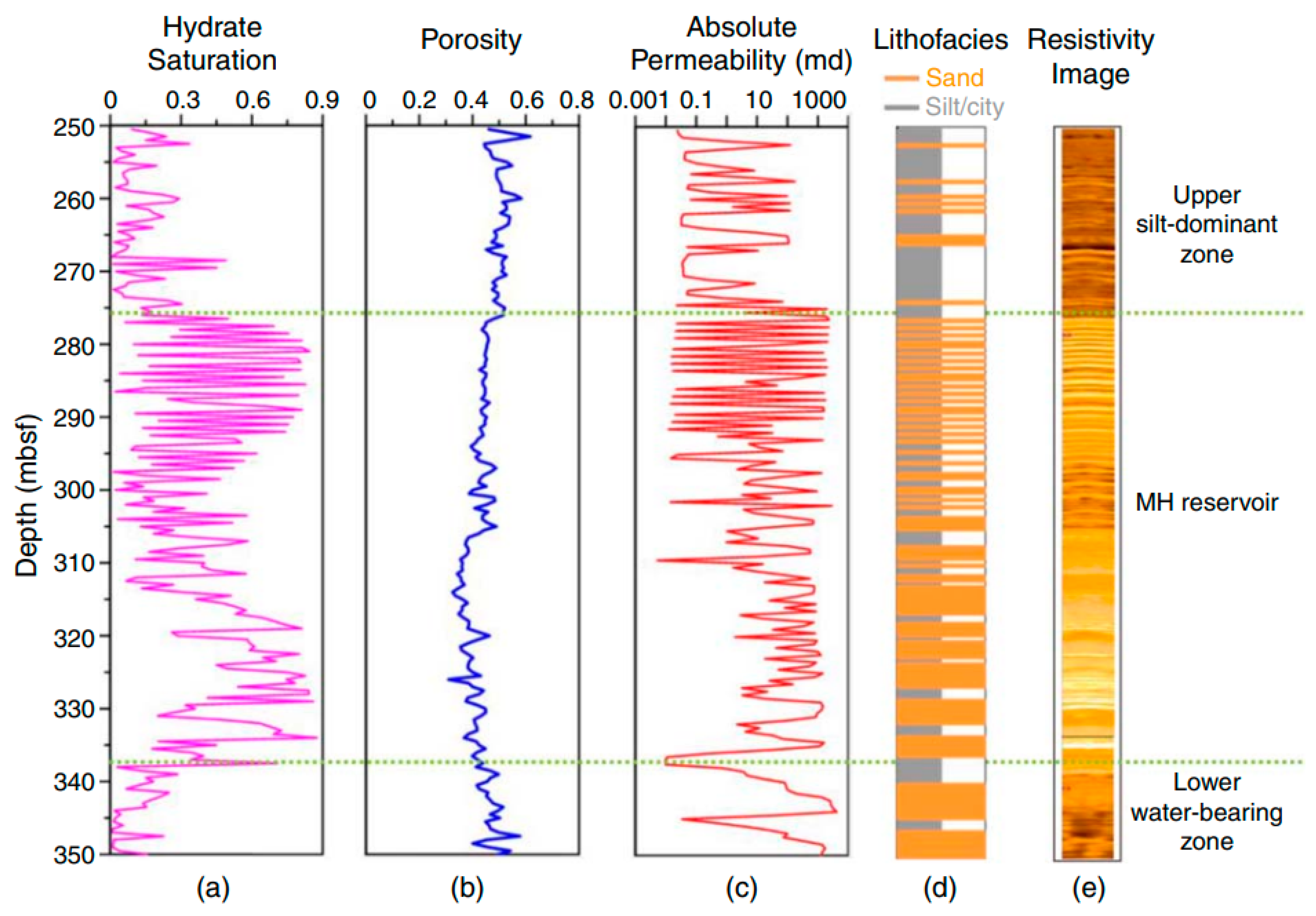
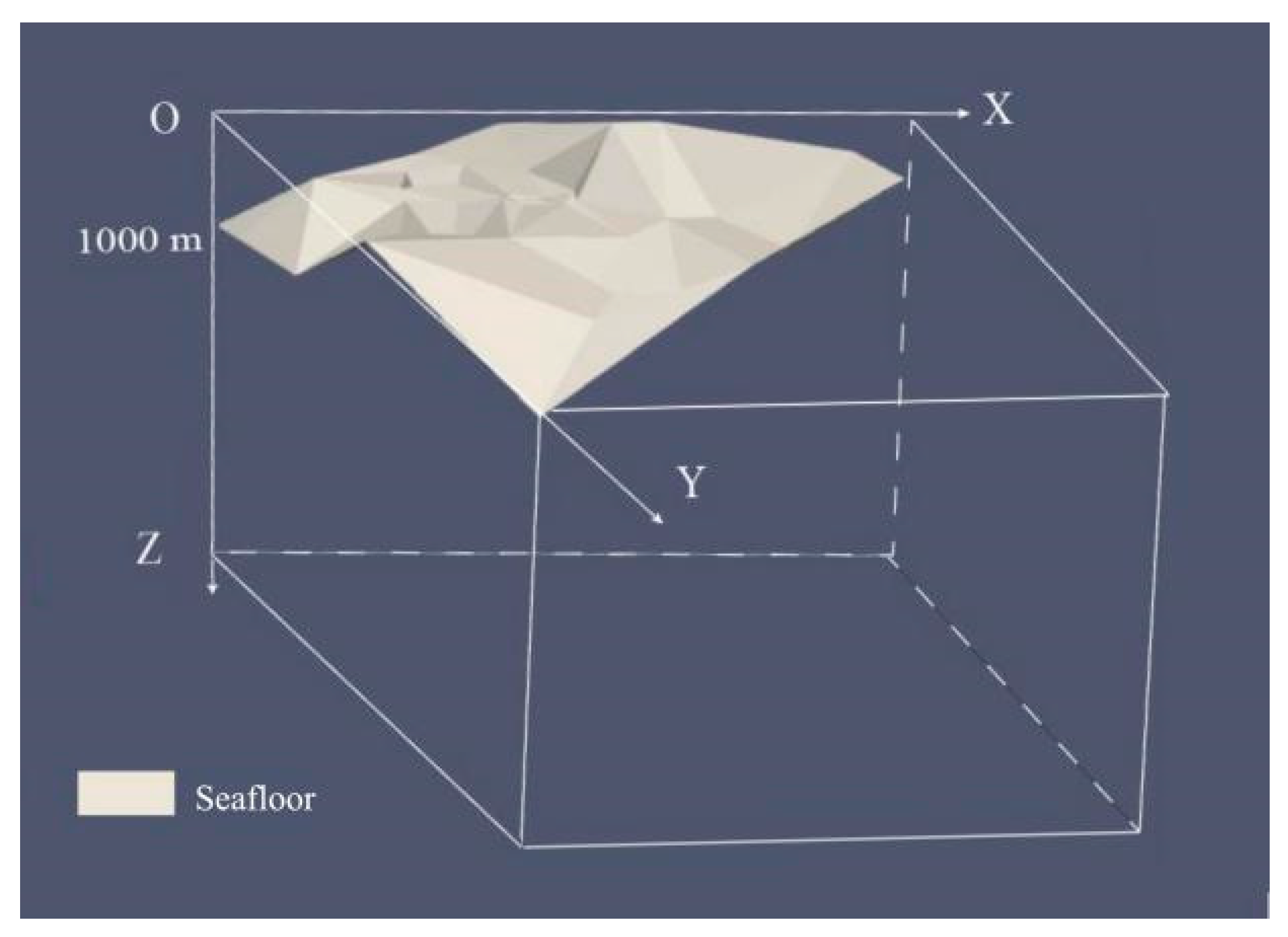
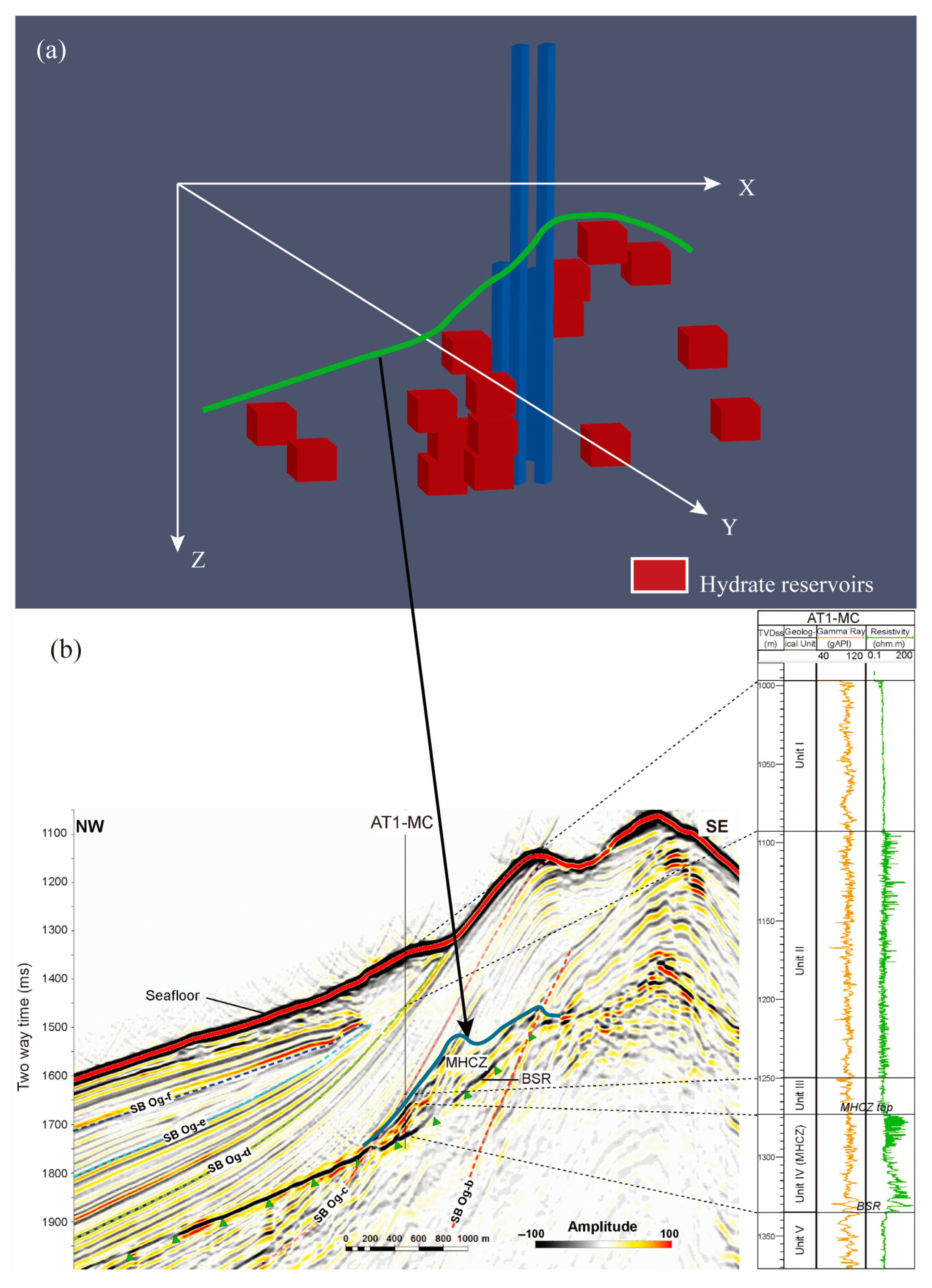

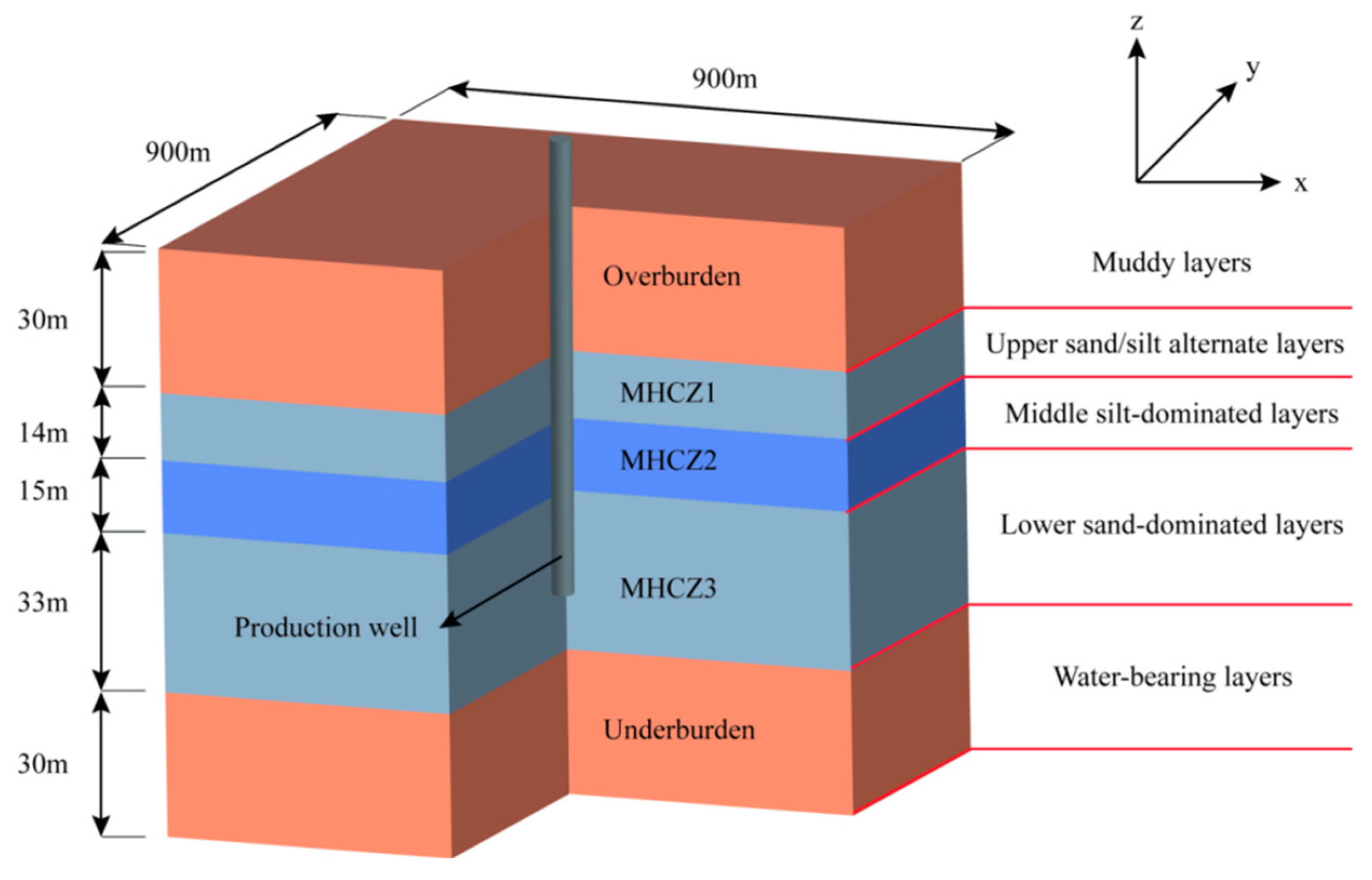
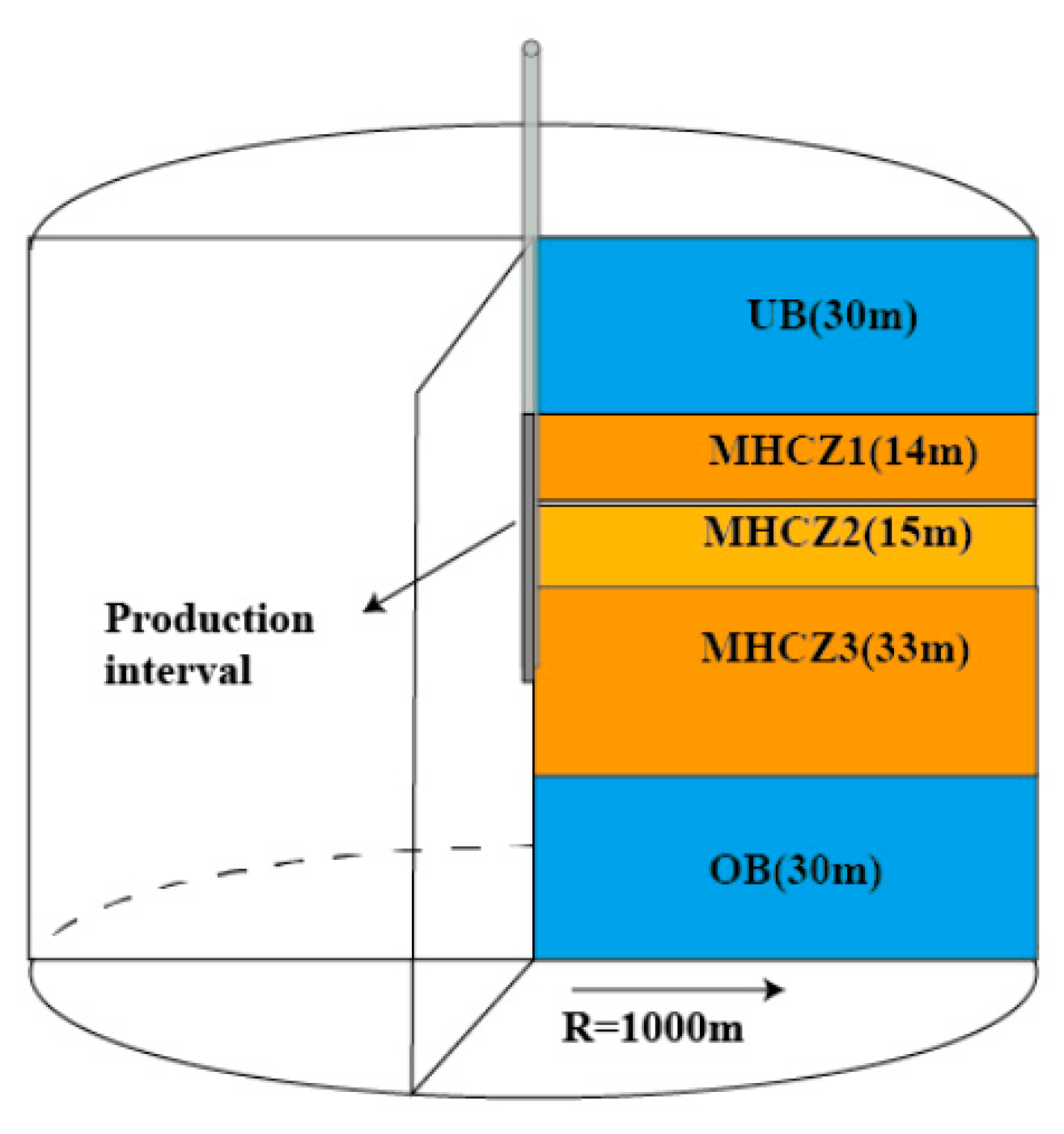
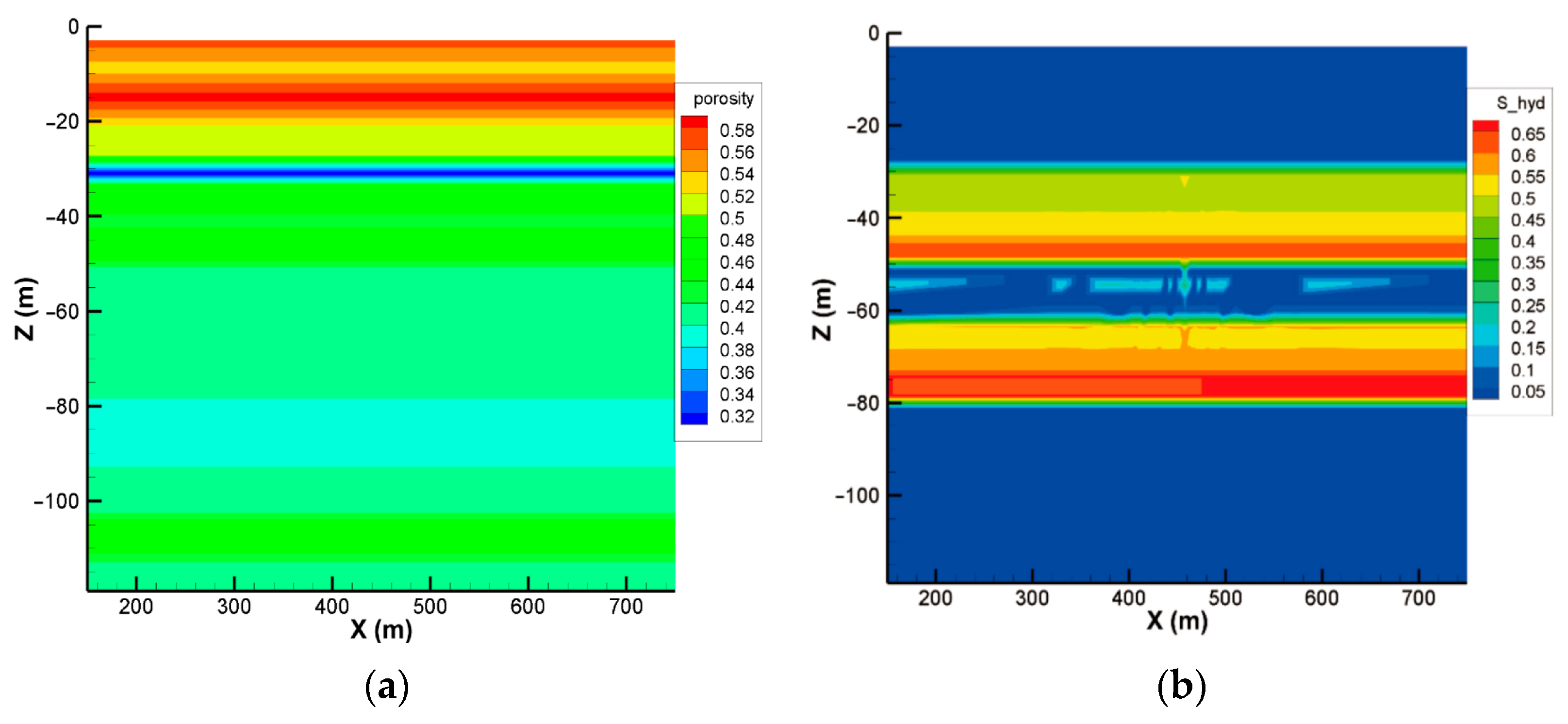
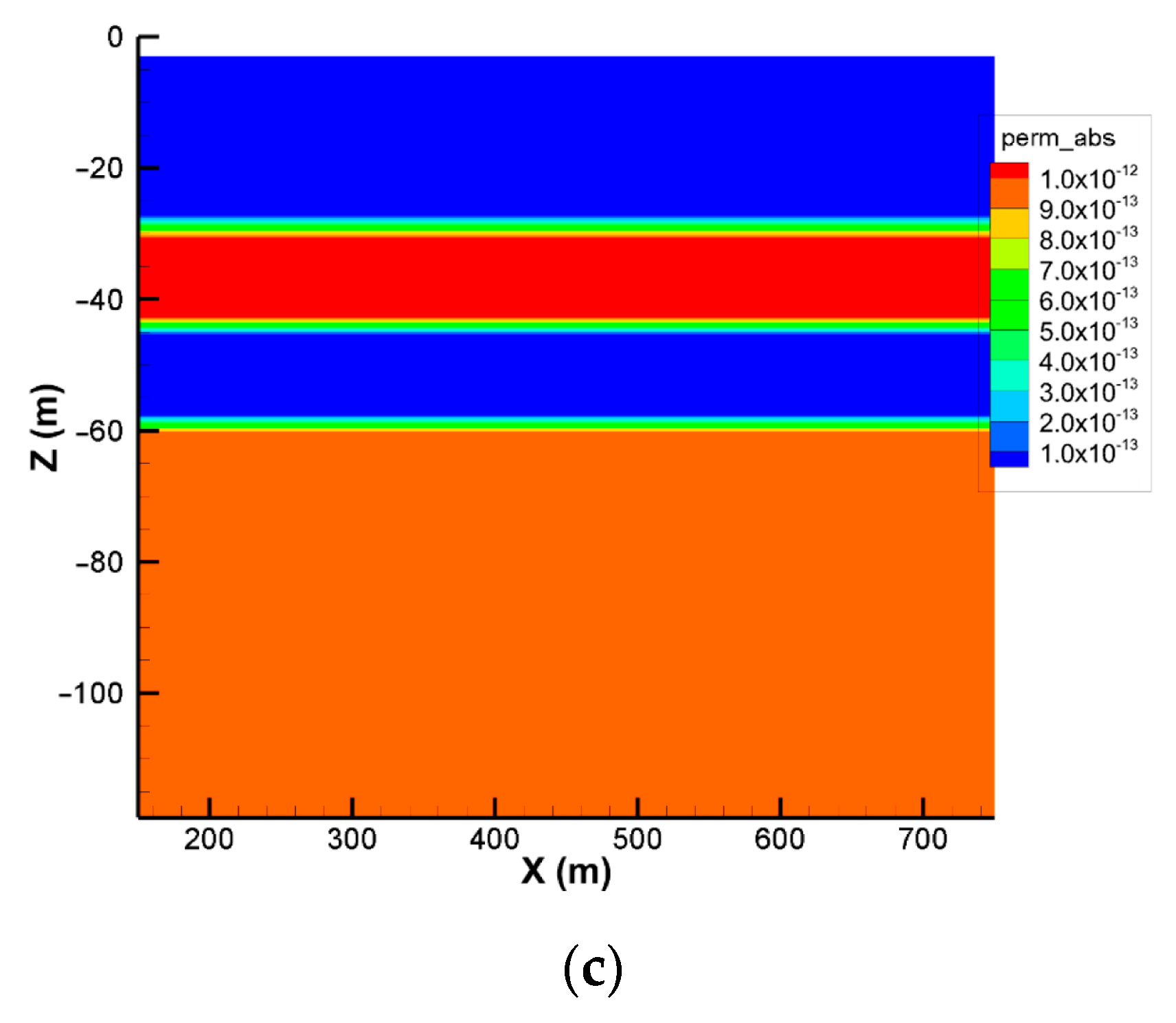
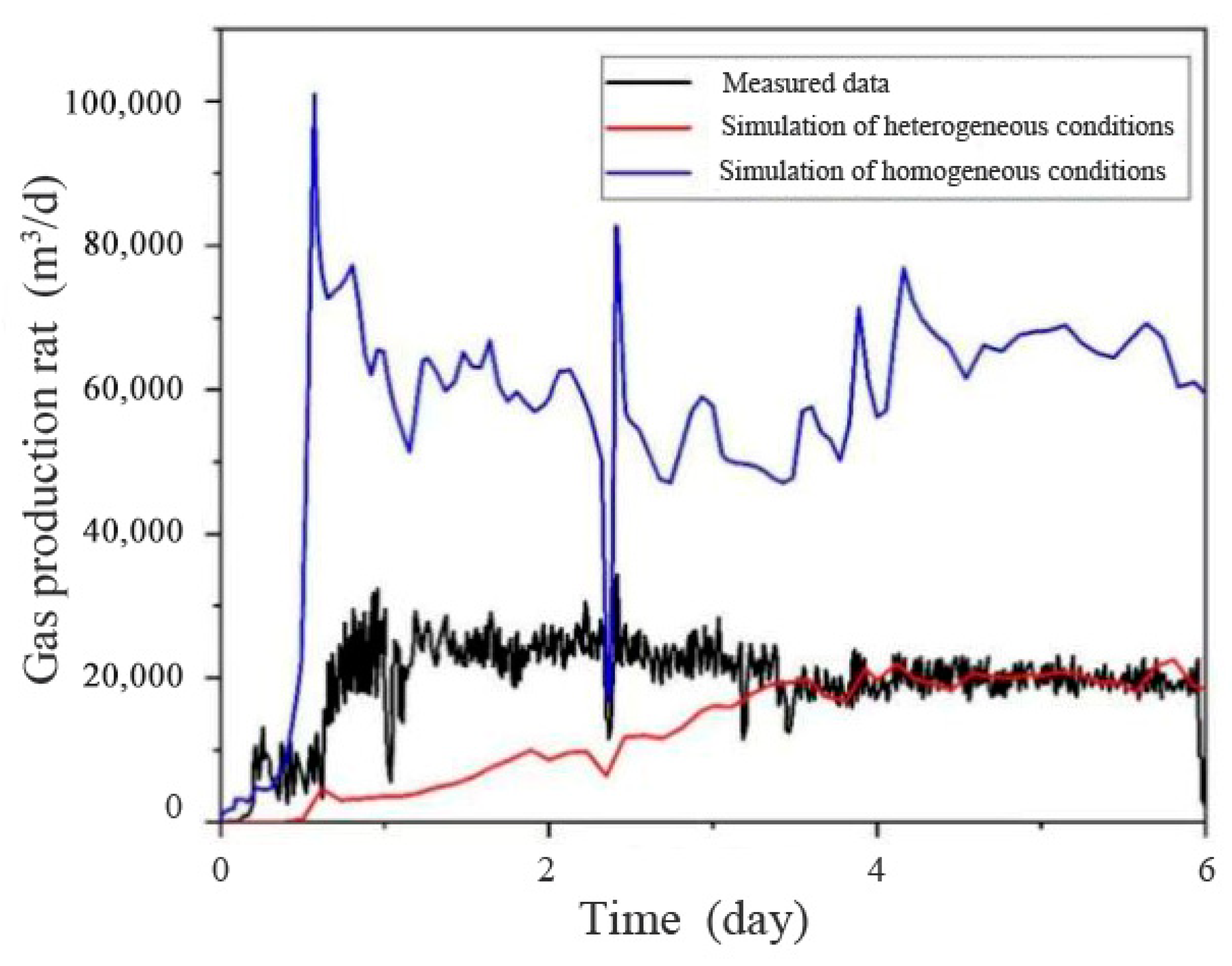

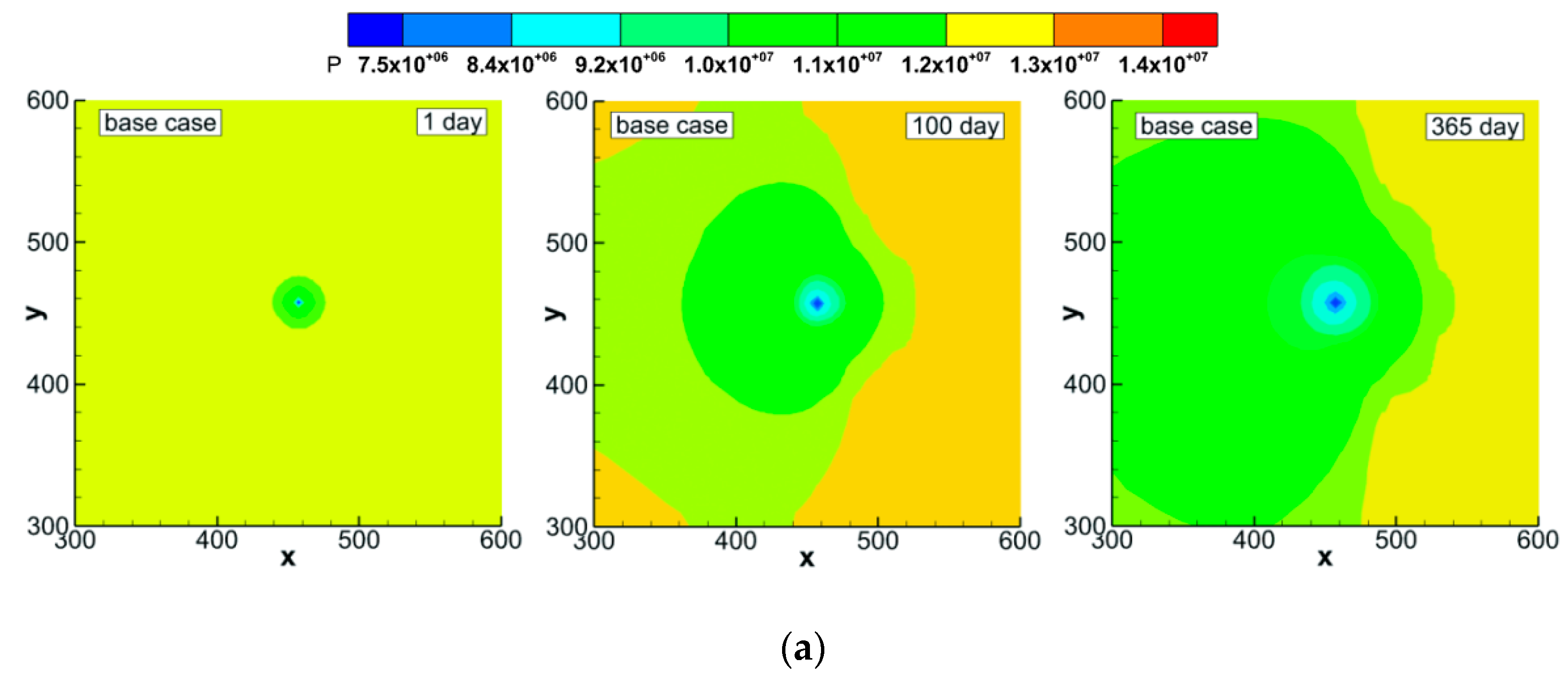
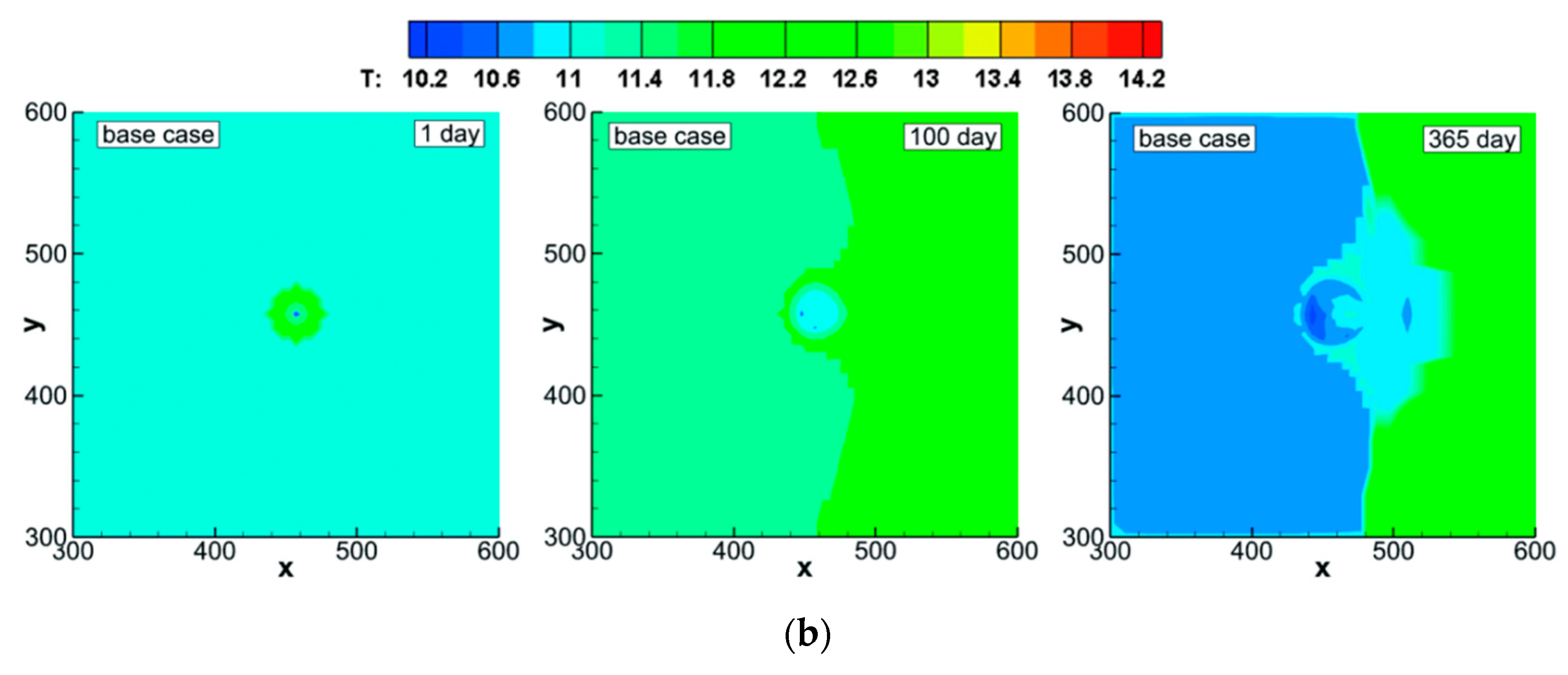
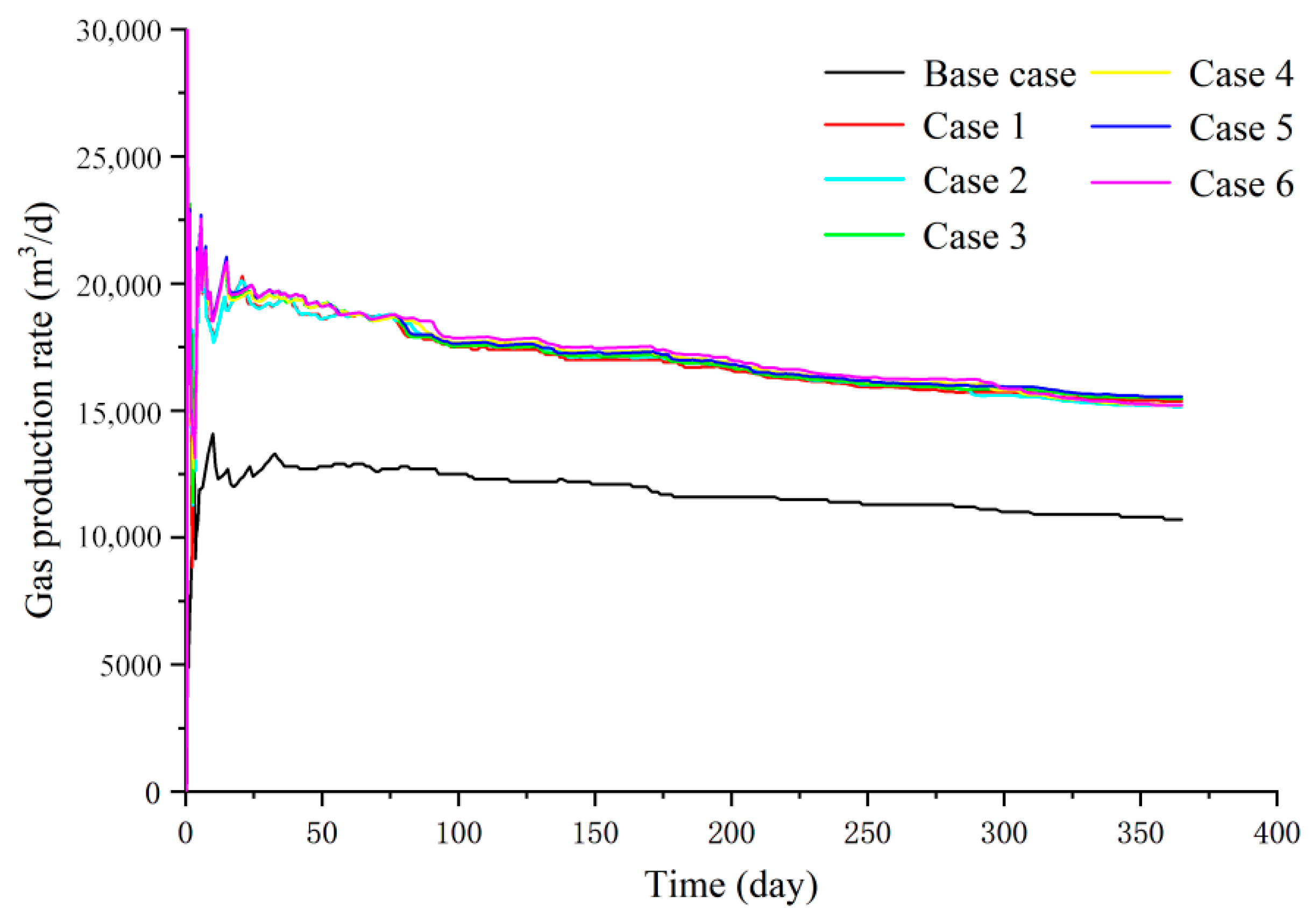
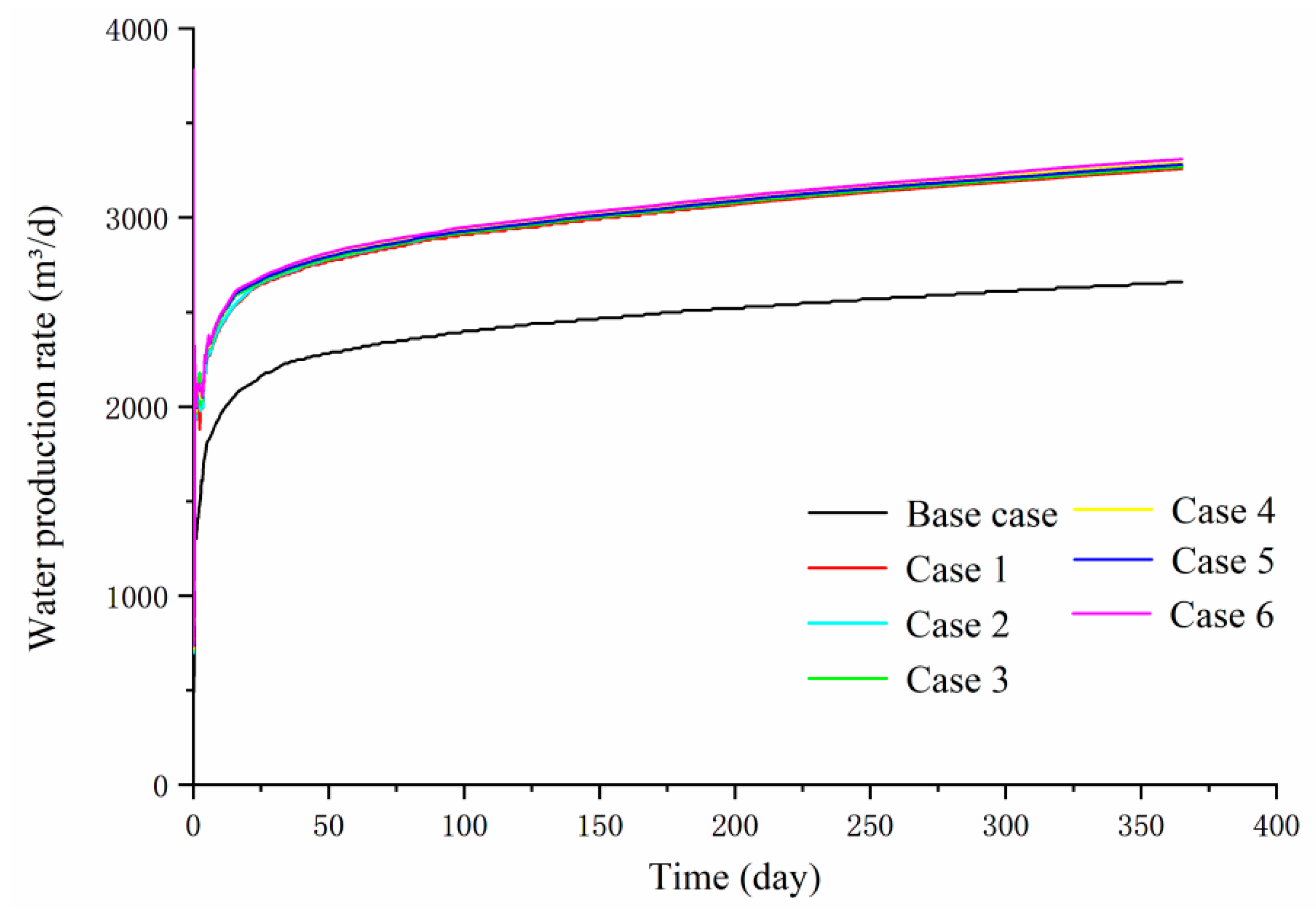
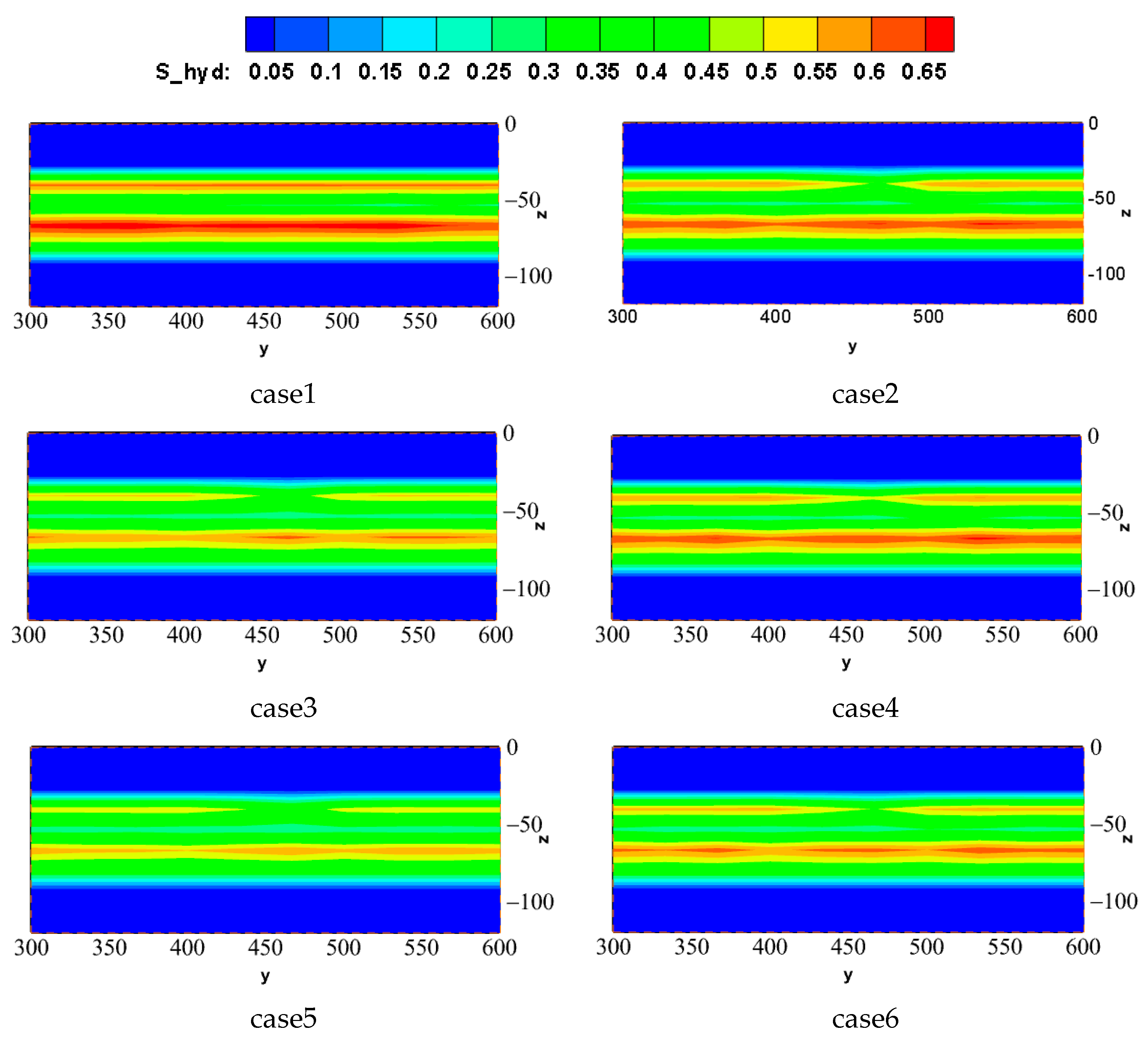
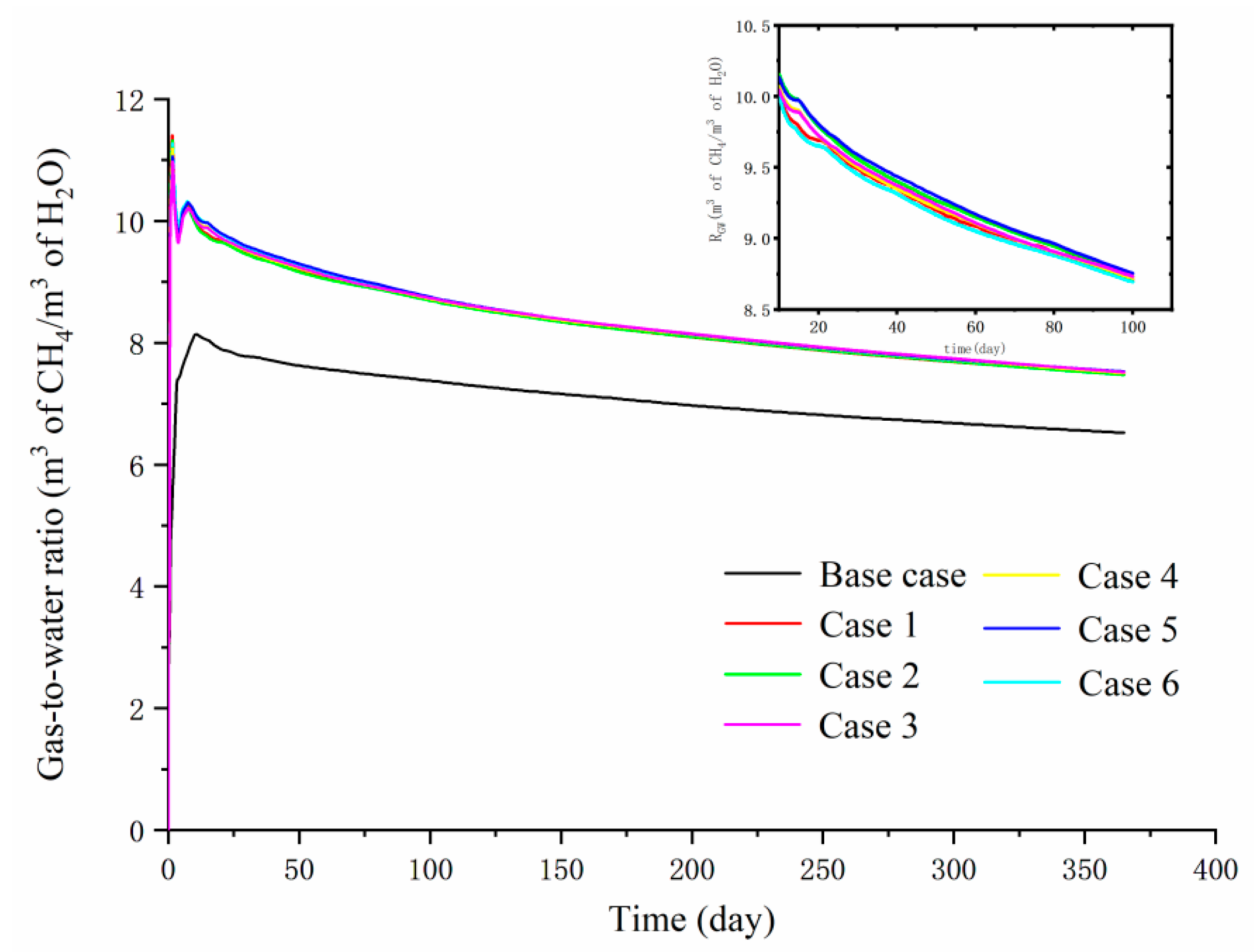
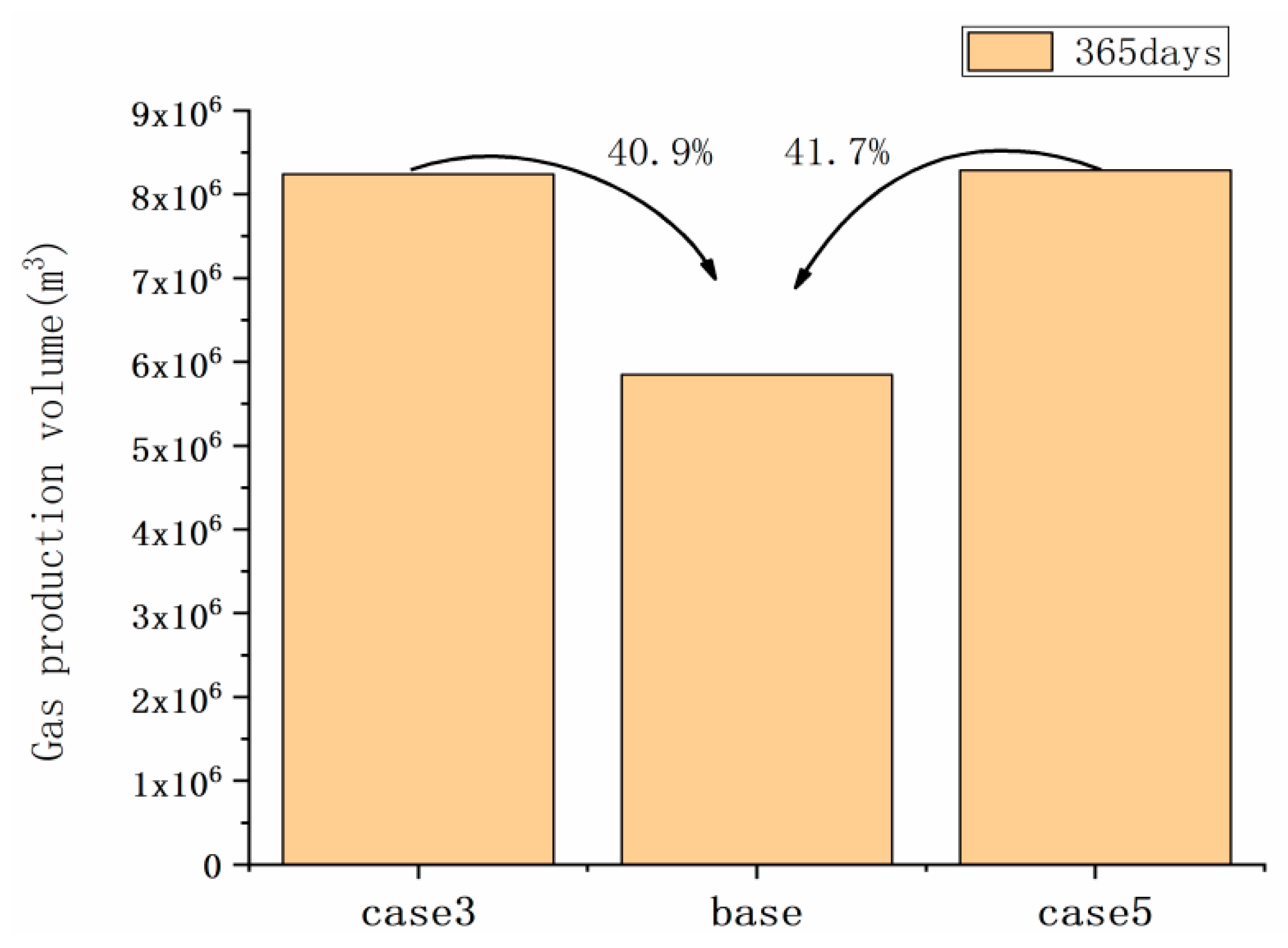
| Parameter | Value | Parameter | Value |
|---|---|---|---|
| Pressure at the top of the mode | 12.6 Mpa | Pressure at the bottom of the model | 13.9 MPa |
| Overburden/underburden thickness | 30/30 m | temperature at the bottom of the model | 14.3 °C |
| MHCZ thickness | 62 m | Geothermal gradient | 0.03 °C/m |
| Gas composition | 100% CH4 | Saturated thermal conductivity | 3.1 W/m/K |
| Water salinity | 0.03 | Unsaturated thermal conductivity | 1.0 W/m/K |
| Diameter of lateral branch | 0.04 m | Diameter of main borehole | 0.1 m |
| Capillary pressure model [30] | SmxA | 1.0 | |
| P0 | 1.0 × 105 MPa | ||
| m | 0.15 (clay), 0.45 (sand) | ||
| SirA | 0.39 (clay), 0.29 (sand) | ||
| Relative permeability mode [31] | nA | 5.0 (clay), 3.5 (sand) | |
| nG | 3.0 (clay), 2.5 (sand) | ||
| SirA | 0.40 (clay), 0.29 (sand) | ||
| SirG | 0.05 (clay), 0.02 (sand) |
| Parameter | Value | |
|---|---|---|
| Porosity | Overburden | 0.43 |
| Underburden | 0.40 | |
| MHCZ1, MHCZ2, MHCZ3 | 0.41, 0.42, 0.40 | |
| Hydrate saturation | MHCZ1, MHCZ2, MHCZ3 | 0.4, 0.1, 0.65 |
| Permeability | Overburden | 1 mD |
| Underburden | 100 mD (XY), 80 mD (Z) | |
| MHCZ1 | 100 mD (XY), 50 mD (Z) | |
| MHCZ2 | 4 mD (XY), 2 mD (Z) | |
| MHCZ3 | 100 mD (XY), 80 mD (Z) | |
| Case | Dip Angle of Lateral Branch | The Number of the Branches | Vertical Depth of Lateral Branches | The Location of the Branches | Lateral Branches Spacing | Phase Angle of Lateral Branches |
|---|---|---|---|---|---|---|
| 1 | 45° | 4 | 14/21 m | MHCZ1/MHCZ3 | 29 m | 180° |
| 2 | 45° | 4 | 14/33 m | MHCZ1/MHCZ2 | 14 m | 180° |
| 3 | 45° | 6 | 14/21 m | MHCZ1/MHCZ3 | 29 m | 90/180° |
| 4 | 45° | 6 | 14/33 m | MHCZ1/MHCZ2 | 14 m | 90/180° |
| 5 | 45° | 8 | 14/21 m | MHCZ1/MHCZ3 | 29 m | 90° |
| 6 | 45° | 8 | 14/33 m | MHCZ1/MHCZ2 | 14 m | 90° |
| Base Case | The single vertical production well | |||||
Disclaimer/Publisher’s Note: The statements, opinions and data contained in all publications are solely those of the individual author(s) and contributor(s) and not of MDPI and/or the editor(s). MDPI and/or the editor(s) disclaim responsibility for any injury to people or property resulting from any ideas, methods, instructions or products referred to in the content. |
© 2023 by the authors. Licensee MDPI, Basel, Switzerland. This article is an open access article distributed under the terms and conditions of the Creative Commons Attribution (CC BY) license (https://creativecommons.org/licenses/by/4.0/).
Share and Cite
Xin, X.; Shan, Y.; Xu, T.; Li, S.; Zhu, H.; Yuan, Y. Multi-Lateral Well Productivity Evaluation Based on Three-Dimensional Heterogeneous Model in Nankai Trough, Japan. Energies 2023, 16, 2406. https://doi.org/10.3390/en16052406
Xin X, Shan Y, Xu T, Li S, Zhu H, Yuan Y. Multi-Lateral Well Productivity Evaluation Based on Three-Dimensional Heterogeneous Model in Nankai Trough, Japan. Energies. 2023; 16(5):2406. https://doi.org/10.3390/en16052406
Chicago/Turabian StyleXin, Xin, Ying Shan, Tianfu Xu, Si Li, Huixing Zhu, and Yilong Yuan. 2023. "Multi-Lateral Well Productivity Evaluation Based on Three-Dimensional Heterogeneous Model in Nankai Trough, Japan" Energies 16, no. 5: 2406. https://doi.org/10.3390/en16052406
APA StyleXin, X., Shan, Y., Xu, T., Li, S., Zhu, H., & Yuan, Y. (2023). Multi-Lateral Well Productivity Evaluation Based on Three-Dimensional Heterogeneous Model in Nankai Trough, Japan. Energies, 16(5), 2406. https://doi.org/10.3390/en16052406








